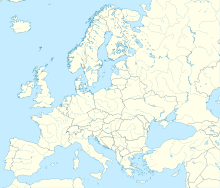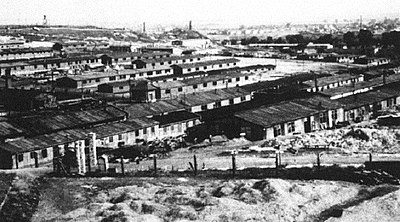Plaszow concentration camp
Plaszow concentration camp in Poland
|
The Plaszow concentration camp , also known as KL Płaszów in recent literature , was a National Socialist concentration camp in Płaszów , a suburb southeast of Kraków , on January 10, 1944, emerged from the Plaszow labor camp of the SS and Police Leader in the Kraków district, which had existed since 1940 .
The last prisoners were deported to Auschwitz on January 14, 1945 , one day before Krakow was liberated.
history
Originally Płaszów was a forced labor camp , which bore the official name of "forced labor camp Płaszów of the SS and Police Leader in the district of Krakow." It was created in the summer of 1940 on a site in Płaszów, southeast of Kraków, which included limestone quarries and two old Jewish cemeteries (New Cemetery at Abrahama Street and Old Cemetery at Jerozolimska Street). The location was extremely unsuitable for a camp, because the ground was stony and hilly, and sometimes also swampy. The camp was built here anyway, because the existing limestone quarries were to be exploited. It was divided into several areas: living quarters for the Germans, workshop or factory area and prison camp. Poles and Jews and men and women were separated. A 4 km long electrically charged double barbed wire fence surrounded the camp. There was a moat between the two fences. There were 13 watchtowers, each equipped with machine guns, telephones and searchlights. Ukrainians, the so-called Trawniki, guarded the area. The National Socialists had Jewish gravestones from the cemeteries abandoned for the construction of the camps used to pave the camp road. Catholic Poles were the first forced laborers in Płaszów. From 1941 Jews were also brought in here. By January 1943 there were a total of around 2,000 forced laborers in the Płaszów labor camp. The majority of the prisoners worked for the SS company, German Equipment Works (DAW) .

At the beginning of February 1943, SS-Untersturmführer Amon Göth , who had been transferred from Lublin to Kraków, was given command of the Płaszów labor camp. Under his leadership, part A of the Krakow ghetto was first cleared and the 8,000 surviving Jewish people were transferred to the Płaszów labor camp, which he directed, so that they could expand it to 81 hectares. Many prisoners died, among them the Jewish architect Diana Reiter, who worked for the Kraków building authorities. She was shot on the orders of Amon Göth because a wall erected under her supervision threatened to collapse. When Part B of the Krakow Ghetto was dissolved on March 13 and 14, 1943, around 2,000 Jews were murdered in the streets there and buried in a mass grave on the camp grounds in Płaszów. The number of inmates in the Płaszów camp rose to 12,000. Hardly any prisoner survived longer than four weeks under Amon Göth's terror regime, whose morning occupation included shooting working prisoners with a bolt-action rifle from the balcony of his villa . He particularly enjoyed setting his two Great Danes on prisoners. He murdered at least 500 people himself. B. Cracow owner of the Bonarka brickworks Ingber, who allegedly did not provide workers quickly enough.
As the commander of Płaszów, he not only earned himself the nickname "Butcher of Płaszów"; he also enriched himself through bribery and black market deals.
The Plaszów concentration camp was the only one of the 20 or so main concentration camps in the area under German rule to emerge from a Jewish residential area, namely the Krakow ghetto. The Płaszów camp was a concentration camp from January 1944, one of the 20 or so main concentration camps and thus organizationally equated with other main camps such as Buchenwald, Sachsenhausen, etc. As a main camp, it was directly subordinate to the SS Economic and Administrative Main Office (WVHA) in Berlin. As a result of the Warsaw Uprising , many Poles arrested there were added as well as around 6,000–8,000 Hungarian Jews in the first half of 1944, so that in the summer of 1944, around 25,000 concentration camp prisoners, the maximum number of people interned in the camp had been reached.
Around 8,000 people were murdered in the concentration camp itself. In addition, there were mass deportations to the Auschwitz-Birkenau concentration camp . On May 14, 1944, around 1,500 camp inmates, mainly children, the elderly and the sick, were transported to Auschwitz for extermination. The last prisoners were deported to Auschwitz on January 14, 1945, one day before Krakow was liberated by Soviet troops.
From September 1944 the concentration camp was dissolved. Because Amon Göth was arrested on September 13, 1944 by the SS justice system because of a complaint by his SS subordinates, his successor Arnold Büscher was responsible. It is not known how many victims the Kraków-Płaszów concentration camp claimed in total.
Movies
Steven Spielberg's film Schindler's List describes the conditions in the Płaszów labor camp under Amon Göth according to scientific research and was shot in Kraków on the area of the former Płaszów labor camp. The film made the camp and Amon Göth known worldwide.
In the documentary Judith and the Man from Schindler's List , which was first broadcast on 3sat in 2011 , concentration camp survivor Michael Emge describes how he and his family were deported to the Płaszów concentration camp in 1943 when he was 14 years old. He was saved, the only one in the family, by Schindler's list. The documentary was partly shot in the remains of the concentration camp, which Emge, over 80 years old, visited again for the first time in 60 years.
literature
- Angelina Awtuszewska-Ettrich: Plaszow - main camp. In: Wolfgang Benz , Barbara Distel (eds.): The place of terror . History of the National Socialist Concentration Camps. Volume 8: Riga, Warsaw, Vaivara, Kaunas, Płaszów, Kulmhof / Chełmno, Bełżec, Sobibór, Treblinka. CH Beck, Munich 2008, ISBN 978-3-406-57237-1 , pp. 235-287.
- Andrea Löw, Markus Roth: Jews in Krakow under German occupation 1939–1945. Wallstein, Göttingen 2011.
- Mieczysław Pemper , V. Hertling, M. Müller: The saving way. Schindler's List - the real story. Hoffmann and Campe, Hamburg 2005, ISBN 3-455-09493-7 .
- Stella Müller-Madej : The girl from the Schindler list. Notes from a concentration camp survivor. dtv, Munich 1998, ISBN 3-423-30664-5 .
- Ana Novac: The beautiful days of my youth. Schöffling & Co., ISBN 978-3-89561-415-6 .
- Matthias Kessler: "I have to love my father, right?" The life story of Monika Göth - daughter of the concentration camp commandant from "Schindler's List". Frankfurt am Main 2002.
- Johannes Sachslehner : Death is a master from Vienna. Life and deeds of Amon Leopold Göth. Styria Premium, 2008, ISBN 978-3-222-13233-9 .
- LG Mosbach, April 24, 1961. In: Justice and Nazi crimes . Collection of German convictions for Nazi homicidal crimes 1945–1966. Volume XVII. Edited by Irene Sagel-Grande, HH Fuchs, CF Rüter . Amsterdam University Press, Amsterdam 1977, No. 506, pp. 233-253. [1] Subject matter of the proceedings: individual shooting of several Jewish forced laborers for various reasons. Mass shooting of 37 Jewish women illegally housed in a labor camp by a German company; of 10 sick Jews from the infirmary of the Plaszow camp; of 11 Jews in a labor column because they allegedly did not march with enough solidity; of at least 11 members of a ZAL Prokocim work detachment who had tried to get food on the way, as well as 6 sick or wounded prisoners when the ZAL Prokocim was dissolved in March 1943.
Web links
- The "butcher of Plaszow": concentration camp commandant Amon Göth - SPIEGEL ONLINE accessed June 24, 2017
- Where the butcher von Plaszow raged In: Die Welt
- Płaszów • A concentration camp of rampant brutality In: Against forgetting
- Plaszow at deathcamps.org
Individual evidence
- ↑ Directory of the concentration camps and their external commands in accordance with Section 42 (2) BEG , No. 767 Krakau-Plaszow (KZ). See also No. 767a Krakau-Plaszow (external command)
- ↑ Martin Buchholz (director): Judith and the man from Schindler's list . Documentary, 45 minutes; Station information on the documentary at 3sat.de; November 3, 2011.
Coordinates: 50 ° 1 ′ 51 ″ N , 19 ° 58 ′ 3 ″ E



